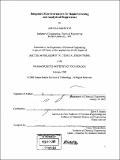Integrated microbioreactors for rapid screening and analysis of bioprocesses
Author(s)
Zanzotto, Andrea, 1975-
DownloadFull printable version (8.007Mb)
Other Contributors
Massachusetts Institute of Technology. Dept. of Chemical Engineering.
Advisor
Klavs F. Jensen.
Terms of use
Metadata
Show full item recordAbstract
(cont.) strains to characterize the bioreactor environment. The ability to reproducibly sacrifice microbioreactors mid-run is exploited to demonstrate the feasibility of linking microbioreactors to genome-wide expression studies using DNA microarrays. The potential of the microbioreactor for investigating different growth conditions is confirmed by comparing bacterial growth, as evaluated by the measured parameters, under conditions of different medium and oxygen concentration. It is shown that statistical differences can be observed, and that these differences are similar to those observed at a larger scale. The demonstrated functionality of the microbioreactor could potentially have a large impact in the numerous fields in which fermentations are used. In bioprocess development, the batch microbioreactor could be used to select strains at all stages of metabolic engineering and to explore and optimize growth conditions during scale-up. The microbioreactor could also be an effective tool in screening applications ranging from toxicology studies that use bacterial reporter strains, to studies that attempt to elucidate metabolic pathways, to intensification of genome-wide expression profiling using either direct links to DNA microarrays or screens of libraries carrying transcription reporters. This thesis presents the design, fabrication, and characterization of a batch microbioreactor with integrated, automated sensors and aeration through a permeable polymer membrane as a step towards establishing high-throughput bioprocessing platforms. In particular, the thesis demonstrates the feasibility of culturing bacterial cells in microliter volumes and obtaining reproducible results similar to those shown at larger scales. A microbioreactor designed to provide sufficient oxygen to a growing culture is fabricated out of PDMS and glass. Models are developed to understand oxygen transport and consumption as well as the kinetics of growth within the microbioreactor. Sensors are integrated to measure the growth parameters optical density (OD), dissolved oxygen (DO), and pH. Based on these measurements as well as cell morphology and total and viable cell counts, reproducibility is established and comparisons to bench-scale bioreactors are made. It is demonstrated that the behavior of bacteria at the two scales is very similar. It is further demonstrated that off-line analysis of the medium can be carried out by serial sacrifice of microbioreactors operating under identical conditions. The test case of HPLC analysis of the fermentation medium to measure glucose consumption and organic acid production is used. Additional sensing capabilities in the form of in situ measurements for luminescence and fluorescence are demonstrated, and a potential glucose sensor is modeled to explore feasibility. Once reproducibility in fabrication, experimental protocol, and experimental results is established, the microbioreactor is used for several applications. The ability to monitor luminescence and fluorescence on-line enables the use of bacterial reporter
Description
Thesis (Ph. D.)--Massachusetts Institute of Technology, Dept. of Chemical Engineering, 2005. Includes bibliographical references (leaves 131-140).
Date issued
2005Department
Massachusetts Institute of Technology. Department of Chemical EngineeringPublisher
Massachusetts Institute of Technology
Keywords
Chemical Engineering.